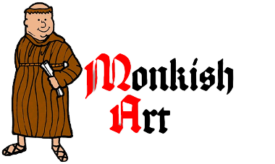 For thousands of years before the advent of the printing press in the 15th century, painting filled the role of illustration in cultures worldwide. The word manuscript means “hand write.” Among them are illuminated manuscripts, which originally meant only manuscripts decorated with gold or silver.
For thousands of years before the advent of the printing press in the 15th century, painting filled the role of illustration in cultures worldwide. The word manuscript means “hand write.” Among them are illuminated manuscripts, which originally meant only manuscripts decorated with gold or silver.
From the 5th to the 13th century, only monasteries produced books. Every monastery was required to have a library and monks produced most of its books on site.
A monastery scriptorium was a large room furnished with wooden chairs and tables that angled up to hold the manuscript pages.
The monks were expected to work in silence and only worked during the day, as lamps and candles were not used near the manuscripts for fear of fire.
The inspiration for our collection comes in the main from three sources:
The Gorleston Psalter is a 14th-century manuscript notable for containing early music instruction and for its humorous marginalia. It is richly illustrated, with frequent illuminations, as well as many bas-de-page (bottom-of-the-page) illustrations or drolleries. The most remarkable feature of this psalter is the use by the artist of animal illustrations. These are not merely pictures of animals, but humorous depictions of animals behaving like humans. For example, a cat dressed as a bishop preaches to a group of ducks. However, oddest of all is a parade of rabbits conducting a funeral.
The Maastricht Hours is a book of hours that was produced in the vicinity of Liège early in the 14th century. It is known for its colourful and imaginative miniatures, often of animals and fantastical creatures, grotesques, pairs of courtly lovers, dancers and musicians, friars and nuns, and scenes of aristocratic pursuits such as hunting and falconry.
The Book of Kells
The Book of Kells was produced by monks of St. Columba’s order of Iona around 800 AD
The work is the most famous of the medieval illuminated manuscripts for the intricacy, detail, and majesty of the illustrations. It is thought the book was created as a showpiece for the altar, not for daily use, because more attention was obviously given to the artwork than the text.
